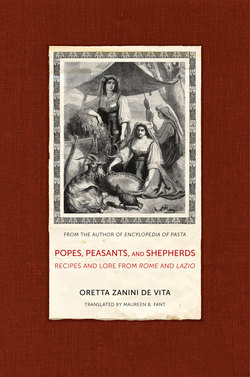Читать книгу Popes, Peasants, and Shepherds - Oretta Zanini De Vita - Страница 26
На сайте Литреса книга снята с продажи.
ОглавлениеThe Papal Table
Like that of the other Italian courts, the kitchen at the papal court was in the hands of able scalchi (high-ranking food-specialist butlers). It was elaborate and costly, completely unrelated to what the general population was eating at the time. Rich and sumptuous or specialized as it might be, it changed not only with the times but also with the tastes of individual popes. Many chroniclers have given us an account of food habits at the papal court, beginning with the rigid ceremonial that regulated the meals of the cardinals when they met in conclave to elect a new pope.
In the Renaissance, a cardinal who attended the conclave103 was followed into his own little room by a large trunk, called a cornuta, which contained the dishes for his meals,104 and by a borsa di credenza, a large bag bearing his family’s coat of arms, which contained various other objects for the cardinal’s table. His seclusion was not exactly golden if the election went on for a long time. Whether it was held in the Sistine Chapel or, later, in the Quirinal Palace, or in some other place, the only means of contact with the outside world was a special passageway for the food, made of two large, revolving doors mounted on a partition. (A kitchen was not installed in the apostolic palaces until the end of the 1700s. Before that, meals were brought, in a colorful procession, directly from the home of each cardinal.)
Just outside the clausura (cloister), a committee of bishops, called the Reveditori (Reviewers), sat behind a long table and carefully checked the bags of food before letting them through. Silver utensils, on which messages could easily be engraved, had recently been prohibited, and so were certain foods, such as pasticci in crosta, or “pies in a crust,” which made perfect hiding places for documents that might influence the nomination of the pontiff.
An army of cooks, scalchi, credenzieri (in charge of the inventory of tableware), and wine stewards was on duty to prepare the meals and serve the fine wines that each cardinal had brought, sometimes from very distant parts.
On occasion, the elections went on too long. Gregory X, elected after three years of balloting, later issued a provision to prevent such a thing from ever happening again. According to these measures, three days after the cardinals entered into the conclave, their meals would be drastically reduced to a single course; and if five days passed without the hoped-for white smoke, a draconian regime of bread and water would go into effect until a successful election took place. Later the rule was eased, but frugality became ritualized.
Once elected to the papal throne, each pope put his particular stamp on his kitchen. Innocent III, for example, who reigned from 1198 to 1216, had very frugal habits and ordered that only one course should appear at his table. Benedict X, on the other hand, owed the brevity of his pontificate (1303–04) to his passion for figs. On a visit to the Dominican monastery in Perugia, some conspirators took advantage of this weakness and served His Holiness a basket of beautiful fresh figs—filled with so much poison that he died within a few hours.
Martin IV (1281–85) was a glutton for eels, especially the tasty fat ones from Lake Bolsena,105 north of Rome. According to a legend reported by more than one historian, he had them brought to his personal apartments, where there was a special tank in which the unfortunate eels were drowned in Vernaccia wine and then roasted. Not satisfied, evidently, to devote himself to affairs of state, this pope saw personally to the preparation of his favorite dish. Dante put him in Purgatory and stigmatized him with the famous lines:
Ebbe la Santa Chiesa in su le braccia;
dal Torso fu, e purga per digiuno
le anguille di Bolsena in la vernaccia.
(He held the Holy Church up in his arms; he was from Tours, and purged by fasting the eels of Lake Bolsena in Vernaccia.)
We do not know how many people mourned Martin IV when he left this world, but certainly the community of eels in Lake Bolsena must have celebrated.
Boniface IX (1389–1404), in civilian life Pietro Tomacelli, is believed to owe his name to an epicurean preparation known as tomaselle (spelled variously in the ancient texts), consisting of liver meatballs wrapped in caul fat, well seasoned, and cooked over coals.
